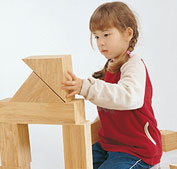Educational benefits of building blocks and sets
April 12, 2015 | Marie-Elaine Leduc, conseillère pédagogique à l’éducation préscolaire, CSDM.
Building blocks and setscan help children develop important skills and competencies. The information in this document was compiled by Marie-Élaine Dupont, an early childhood education consultant, to illustrate the “potential contribution [of such play] to the development of the target competencies of the Quebec Education Program for the preschool level.”
Background:
There is a regrettable tendency to eliminate certain toys and activities, such as building blocks and sand and water play, from preschool classrooms. The reasons are rational enough: too noisy, too messy. And yet these activities offer many educational benefits for children ages 4 and 5. In fact, their versatility and transdisciplinary nature make them a good fit with the target competencies of Quebec’s preschool education program.
Educational benefits of playing with building blocks and sets, as linked to the target competencies of the Quebec Education Program (preschool education)
Competency 1: To perform sensorimotor actions effectively in different contexts
- Fine motor skills
- Gross motor skills (used, for example, when playing with hollow oversize blocks)
- Dissociation
- Dexterity, precision
- Eye-hand coordination
- Visual perception
- Tactile stimulation
- Position of objects in space, spatial relationships
- Concepts of sturdiness and security
Competency 2: To affirm his/her personality
- Feeling of competency
- Sense of accomplishment (building, deciding, creating large structures)
- Initiative
- Aesthetic satisfaction
- Self-esteem
- Setting personal goals, taking risks
- Dealing with frustration (as when, for instance, a structure collapses)
- Expressing interests and preferences
- Self-confidence
Competency 3: To interact harmoniously with others
- Respect for others’ work
- Cooperation (deciding what to build, assigning roles, sharing material)
- Conflict resolution
Competency 4: To communicate using the resources of language
- Planning a project as a group (verbalizing)
- Asking questions about the chosen theme and the building process
- Exchanging ideas and solutions
- Resolving conflicts
- Understanding principles and processes
- Learning vocabulary: shapes and volumes, blocks and pieces, construction and built structures (e.g., a castle drawbridge and buttresses)
- Making up stories and having discussions about the project
Competency 5: To construct his/her understanding of the world
Visual art
- Experiencing the joy of creating
- Admiring examples (photos, models) of different structures around the world
- Learning about architecture (parts of a building) and architects (signature works)
- Symmetry
- Rhythm
- Colour (when using coloured blocks)
- Decorative elements
- Models
- Vocabulary: art terminology
- Learning about artists
Science and technology
- Trial and error
- Predicting, inductive reasoning
- Anticipating what each block will do (visualization)
- Discovery
- Formulating and testing a hypothesis
- Developing a theory
- Gravity
- Stability
- Cause and effect
- Properties of different materials
- Inclined planes
- Equilibrium
- Interaction of forces
- Systems
- Motion transfer (e.g., wheel sets)
Representational ability
- Imagining (forming a mental picture) and expressing
- Symbolically representing places and events (hospital, school,…)
- Building models
- Reading and creating maps and plans
Mathematics
- Volume
- Regular and irregular forms
- Open and closed forms
- Lines: continuous/discontinuous, parallel/intersecting, straight/curved/sinuous
- Surfaces (block faces, areas)
- Weight
- Height
- Length
- Width
- Thickness
- Depth
- Dimensions
- Area
- Symmetry
- Angles
- Equivalencies and substitutions (small pieces can be combined to make/replace larger ones)
- Spatial relationships
- Perspectives
- Near/far
- Number/quantity
- Fractions
- Addition
- Subtraction
- Equality (identical to, same as) and inequality (greater/larger than, lesser/smaller than)
- Comparison
- Classification
- Vocabulary: mathematical terminology
- Proximity
- Order (series)
- Enclosure (concept of interior/exterior)
- Proportion and scale
- Shadows and shapes
Competency 6: To complete an activity or project
- Planning an activity or project
- Perseverance, dedication, applied effort (working in a sustained way)
- Anticipating next steps
- Presenting final results, describing what happened, difficulties encountered and solutions found
- Evaluating the overall experience (relationship with classmates, project method, degree of satisfaction with the final “product”)
- Expressing degree of satisfaction

A recent study (Verdine, Golinkoff, Hirsh-Pasek, and Newcombe 2013) found that children of lower socioeconomic status (SES) had relatively few opportunities to play with building blocks and sets, and therefore had less developed spatial skills. The study also found that lower-SES parents reported using significantly fewer spatial words with their children. The researchers highlighted the vital importance of including spatial play in the preschool curriculum for children age 4, and encouraged preschool teachers to use spatial vocabulary with their students.
Content based on the work of Anne Gillain-Mauffette, a retired educator from the Outaouais region of Quebec.










Comments
There are no comments about this article.